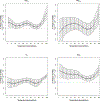Joint effect of heat and air pollution on mortality in 620 cities of 36 countries
- PMID: 37837748
- PMCID: PMC10702017
- DOI: 10.1016/j.envint.2023.108258
Joint effect of heat and air pollution on mortality in 620 cities of 36 countries
Abstract
Background: The epidemiological evidence on the interaction between heat and ambient air pollution on mortality is still inconsistent.
Objectives: To investigate the interaction between heat and ambient air pollution on daily mortality in a large dataset of 620 cities from 36 countries.
Methods: We used daily data on all-cause mortality, air temperature, particulate matter ≤ 10 μm (PM10), PM ≤ 2.5 μm (PM2.5), nitrogen dioxide (NO2), and ozone (O3) from 620 cities in 36 countries in the period 1995-2020. We restricted the analysis to the six consecutive warmest months in each city. City-specific data were analysed with over-dispersed Poisson regression models, followed by a multilevel random-effects meta-analysis. The joint association between air temperature and air pollutants was modelled with product terms between non-linear functions for air temperature and linear functions for air pollutants.
Results: We analyzed 22,630,598 deaths. An increase in mean temperature from the 75th to the 99th percentile of city-specific distributions was associated with an average 8.9 % (95 % confidence interval: 7.1 %, 10.7 %) mortality increment, ranging between 5.3 % (3.8 %, 6.9 %) and 12.8 % (8.7 %, 17.0 %), when daily PM10 was equal to 10 or 90 μg/m3, respectively. Corresponding estimates when daily O3 concentrations were 40 or 160 μg/m3 were 2.9 % (1.1 %, 4.7 %) and 12.5 % (6.9 %, 18.5 %), respectively. Similarly, a 10 μg/m3 increment in PM10 was associated with a 0.54 % (0.10 %, 0.98 %) and 1.21 % (0.69 %, 1.72 %) increase in mortality when daily air temperature was set to the 1st and 99th city-specific percentiles, respectively. Corresponding mortality estimate for O3 across these temperature percentiles were 0.00 % (-0.44 %, 0.44 %) and 0.53 % (0.38 %, 0.68 %). Similar effect modification results, although slightly weaker, were found for PM2.5 and NO2.
Conclusions: Suggestive evidence of effect modification between air temperature and air pollutants on mortality during the warm period was found in a global dataset of 620 cities.
Keywords: Air pollution; Air temperature; Effect modification; Epidemiology; Mortality.
Copyright © 2023 The Authors. Published by Elsevier Ltd.. All rights reserved.
Conflict of interest statement
Declaration of Competing Interest The authors declare that they have no known competing financial interests or personal relationships that could have appeared to influence the work reported in this paper.
Figures



References
-
- Analitis A, Michelozzi P, D’Ippoliti D, de’Donato F, Menne B, Matthies F, Atkinson RW, Iñiguez C, Basagaña X, Schneider A, Lefranc A, Paldy A, Bisanti L, Katsouyanni K, 2014. Effects of heat waves on mortality: effect modification and confounding by air pollutants. Epidemiology 25 (1), 15–22. - PubMed
-
- Bouchama A, Dehbi M, Mohamed G, Matthies F, Shoukri M, Menne B, 2007. Prognostic factors in heat wave related deaths: a meta-analysis. Arch. Intern. Med. 167, 2170–2176. - PubMed

